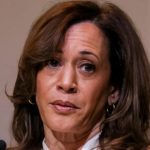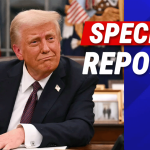
President Donald Trump has remained steadfast in his approach to international trade. The newly implemented tariffs have sparked global tensions. Major economies are now scrambling to respond. Indeed, markets around the world experienced significant volatility last week. Investors are adjusting to the new economic landscape. The mainstream media is having a field day with doom-and-gloom predictions – but when have they ever gotten it right about Trump’s economic policies?
“This is a great time to get rich,” Trump declared on Truth Social as markets tumbled. The bold statement came after his “Liberation Day” tariffs triggered market selloffs and international backlash. I can’t help but admire his unflinching confidence while the economic establishment clutches their pearls.
China quickly announced retaliatory measures. Beijing unveiled new 34-percent tariffs on American imports starting April 10.
From ‘Breitbart News’:
“China played it wrong, they panicked — the one thing they cannot afford to do!” Trump posted on Truth Social, writing the message in his trademark all-caps.
The Chinese government also plans to restrict exports of rare earth elements. These materials are crucial for high-end medical equipment and electronics technology. It’s a desperate move from a regime that’s grown far too comfortable exploiting American markets.
Wall Street felt the immediate impact. The Dow Jones dropped 5.5 percent while the S&P fell nearly 6 percent. Losses in U.S. financial markets were estimated at more than $6 trillion since the tariffs were announced. Yet President Trump remained unwavering. Why couldn’t previous administrations show this kind of backbone?
China Retaliates, Trump Stands Firm
Trump dismissed concerns about market reactions. “My policies will never change,” he stated firmly. Trump’s economic vision focuses on American manufacturing strength. The strategy aims to force foreign companies to produce on U.S. soil rather than import goods. “ONLY THE WEAK WILL FAIL!” Trump declared in another Truth Social post. His message reflected confidence despite the market turbulence. When’s the last time we had a leader willing to weather short-term pain for long-term American prosperity?
Federal Reserve Chairman Jerome Powell warned the tariffs could lead to “higher inflation and lower growth.” His comments added to market jitters. Trump quickly responded to Powell’s assessment. “CUT INTEREST RATES, JEROME, AND STOP PLAYING POLITICS!” he posted, pressing for monetary policy support.
Global Markets React as America Leads
International reactions have been mixed. The European Union, hit with a 20-percent tariff, is planning a measured response. EU trade chief Maros Sefcovic promised a “calm, carefully phased, unified” approach. However, he warned the bloc “won’t stand idly by.” Typical bureaucratic handwringing from Brussels. France and Germany suggested taxing U.S. tech companies. French Economy Minister Eric Lombard urged French companies to show “patriotism” rather than investing in America. Japan’s Prime Minister called for a “calm-headed” approach. Japanese automaker Nissan announced plans to increase U.S. production.
Sweden’s Volvo, owned by China’s Geely, also said it would boost American manufacturing operations. These moves suggest Trump’s strategy may be working as intended. Imagine that – a trade policy that actually benefits American workers!
America First: The Strategy Behind the Tariffs
The tariff strategy represents a significant shift from decades of globalist trade policies. Previous administrations often prioritized cheap imports over domestic manufacturing. How many American communities were sacrificed on the altar of “free trade”?
Some Republican allies have expressed concern. Senator Ted Cruz worried the tariffs could “hurt jobs and hurt America” – a rare criticism from a Trump loyalist. Democrats predictably attacked the President’s approach. Senator Amy Klobuchar claimed Trump is “messing around with people’s lives… while he’s out golfing!” Pure political theater from a party with no economic vision of their own.
The tariffs have already impacted consumer products. Nintendo announced delays for its Switch 2 gaming console as it assesses the “evolving” trade conditions. Trump’s long-term vision focuses on American economic independence. The immediate market pain could lead to stronger domestic industries and reduced reliance on foreign nations.
The President’s approach challenges conventional economic wisdom. Traditional conservative thinkers have historically favored free trade with minimal government intervention. However, Trump’s tariff strategy recognizes that China and other nations haven’t played by fair trade rules. American workers have paid the price for decades of unbalanced trade agreements. It takes real courage to challenge the economic orthodoxy that’s failed working Americans.
Key Takeaways:
- Trump’s tariff strategy prioritizes American manufacturing over short-term market gains.
- China’s panicked response reveals vulnerability in their economic position.
- Major companies are already shifting production to American soil.
- Economic sovereignty is essential for both national security and long-term prosperity.
Source: Breitbart


